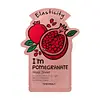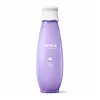What's inside
What's inside
 Key Ingredients
Key Ingredients

 Benefits
Benefits

 Concerns
Concerns

 Ingredients Side-by-side
Ingredients Side-by-side

Water
Skin ConditioningGlycerin
HumectantButylene Glycol
HumectantPEG/PPG-17/6 Copolymer
SolventGlycereth-26
HumectantPanthenol
Skin ConditioningBis-Ethoxydiglycol Succinate
HumectantAllantoin
Skin ConditioningPEG-60 Hydrogenated Castor Oil
EmulsifyingChlorphenesin
AntimicrobialCarbomer
Emulsion StabilisingPhenoxyethanol
PreservativeTromethamine
BufferingHydroxyethylcellulose
Emulsion StabilisingPunica Granatum Fruit Extract
Antioxidant1,2-Hexanediol
Skin ConditioningPropanediol
SolventHydrolyzed Collagen
EmollientCaprylyl Glycol
EmollientIllicium Verum Fruit Extract
PerfumingHydrolyzed Elastin
EmollientDisodium EDTA
Parfum
MaskingWater, Glycerin, Butylene Glycol, PEG/PPG-17/6 Copolymer, Glycereth-26, Panthenol, Bis-Ethoxydiglycol Succinate, Allantoin, PEG-60 Hydrogenated Castor Oil, Chlorphenesin, Carbomer, Phenoxyethanol, Tromethamine, Hydroxyethylcellulose, Punica Granatum Fruit Extract, 1,2-Hexanediol, Propanediol, Hydrolyzed Collagen, Caprylyl Glycol, Illicium Verum Fruit Extract, Hydrolyzed Elastin, Disodium EDTA, Parfum
Vaccinium Angustifolium Fruit Extract 88%
Skin ProtectingButylene Glycol
HumectantGlycereth-26
Humectant1,2-Hexanediol
Skin ConditioningPanthenol
Skin ConditioningDiethoxyethyl Succinate
SolventBetaine
HumectantPEG-60 Hydrogenated Castor Oil
EmulsifyingPhenoxyethanol
PreservativeAmmonium Acryloyldimethyltaurate/Vp Copolymer
Disodium EDTA
Parfum
MaskingCoco-Caprylate/Caprate
EmollientVitis Vinifera Seed Oil
EmollientPrunus Armeniaca Kernel Oil
MaskingSolanum Lycopersicum Seed Oil
EmollientPunica Granatum Seed Oil
EmollientMangifera Indica Seed Oil
EmollientCitrus Paradisi Seed Oil
PerfumingTocopherol
AntioxidantVaccinium Angustifolium Fruit Extract 88%, Butylene Glycol, Glycereth-26, 1,2-Hexanediol, Panthenol, Diethoxyethyl Succinate, Betaine, PEG-60 Hydrogenated Castor Oil, Phenoxyethanol, Ammonium Acryloyldimethyltaurate/Vp Copolymer, Disodium EDTA, Parfum, Coco-Caprylate/Caprate, Vitis Vinifera Seed Oil, Prunus Armeniaca Kernel Oil, Solanum Lycopersicum Seed Oil, Punica Granatum Seed Oil, Mangifera Indica Seed Oil, Citrus Paradisi Seed Oil, Tocopherol
 Reviews
Reviews

Ingredients Explained
These ingredients are found in both products.
Ingredients higher up in an ingredient list are typically present in a larger amount.
1,2-Hexanediol is a synthetic liquid and another multi-functional powerhouse.
It is a:
- Humectant, drawing moisture into the skin
- Emollient, helping to soften skin
- Solvent, dispersing and stabilizing formulas
- Preservative booster, enhancing the antimicrobial activity of other preservatives
Butylene Glycol (or BG) is used within cosmetic products for a few different reasons:
Overall, Butylene Glycol is a safe and well-rounded ingredient that works well with other ingredients.
Though this ingredient works well with most skin types, some people with sensitive skin may experience a reaction such as allergic rashes, closed comedones, or itchiness.
Learn more about Butylene GlycolDisodium EDTA plays a role in making products more stable by aiding other preservatives.
It is a chelating agent, meaning it neutralizes metal ions that may be found in a product.
Disodium EDTA is a salt of edetic acid and is found to be safe in cosmetic ingredients.
Learn more about Disodium EDTAGlycereth-26 is a synthetic ingredient and polyethylene glycol ether of Glycerin. Glycerin is already naturally found in your skin and helps keep your skin moisturized.
It is a humectant and helps add texture to products. It can make your product thicker.
As a humectant, it helps draw moisture from the air to your skin. This helps your skin stay hydrated.
Learn more about Glycereth-26Panthenol is a common ingredient that helps hydrate and soothe the skin. It is found naturally in our skin and hair.
There are two forms of panthenol: D and L.
D-panthenol is also known as dexpanthenol. Most cosmetics use dexpanthenol or a mixture of D and L-panthenol.
Panthenol is famous due to its ability to go deeper into the skin's layers. Using this ingredient has numerous pros (and no cons):
Like hyaluronic acid, panthenol is a humectant. Humectants are able to bind and hold large amounts of water to keep skin hydrated.
This ingredient works well for wound healing. It works by increasing tissue in the wound and helps close open wounds.
Once oxidized, panthenol converts to pantothenic acid. Panthothenic acid is found in all living cells.
This ingredient is also referred to as pro-vitamin B5.
Learn more about PanthenolParfum is a catch-all term for an ingredient or more that is used to give a scent to products.
Also called "fragrance", this ingredient can be a blend of hundreds of chemicals or plant oils. This means every product with "fragrance" or "parfum" in the ingredients list is a different mixture.
For instance, Habanolide is a proprietary trade name for a specific aroma chemical. When used as a fragrance ingredient in cosmetics, most aroma chemicals fall under the broad labeling category of “FRAGRANCE” or “PARFUM” according to EU and US regulations.
The term 'parfum' or 'fragrance' is not regulated in many countries. In many cases, it is up to the brand to define this term.
For instance, many brands choose to label themselves as "fragrance-free" because they are not using synthetic fragrances. However, their products may still contain ingredients such as essential oils that are considered a fragrance by INCI standards.
One example is Calendula flower extract. Calendula is an essential oil that still imparts a scent or 'fragrance'.
Depending on the blend, the ingredients in the mixture can cause allergies and sensitivities on the skin. Some ingredients that are known EU allergens include linalool and citronellol.
Parfum can also be used to mask or cover an unpleasant scent.
The bottom line is: not all fragrances/parfum/ingredients are created equally. If you are worried about fragrances, we recommend taking a closer look at an ingredient. And of course, we always recommend speaking with a professional.
Learn more about ParfumPeg-60 Hydrogenated Castor Oil comes from hydrogenated castor oil. It is a solubilizer and emulsifier.
As a solubilizer, it helps dissolve ingredients into a water-based version. It is also an emulsifer. Emulsifier help prevent oils and water from separating. Both these properties help create evenly-spread and uniform products.
Basically, Peg-60 Hydrogenated Castor Oil helps hold ingredients together.
Learn more about PEG-60 Hydrogenated Castor OilPhenoxyethanol is a preservative that has germicide, antimicrobial, and aromatic properties. Studies show that phenoxyethanol can prevent microbial growth. By itself, it has a scent that is similar to that of a rose.
It's often used in formulations along with Caprylyl Glycol to preserve the shelf life of products.